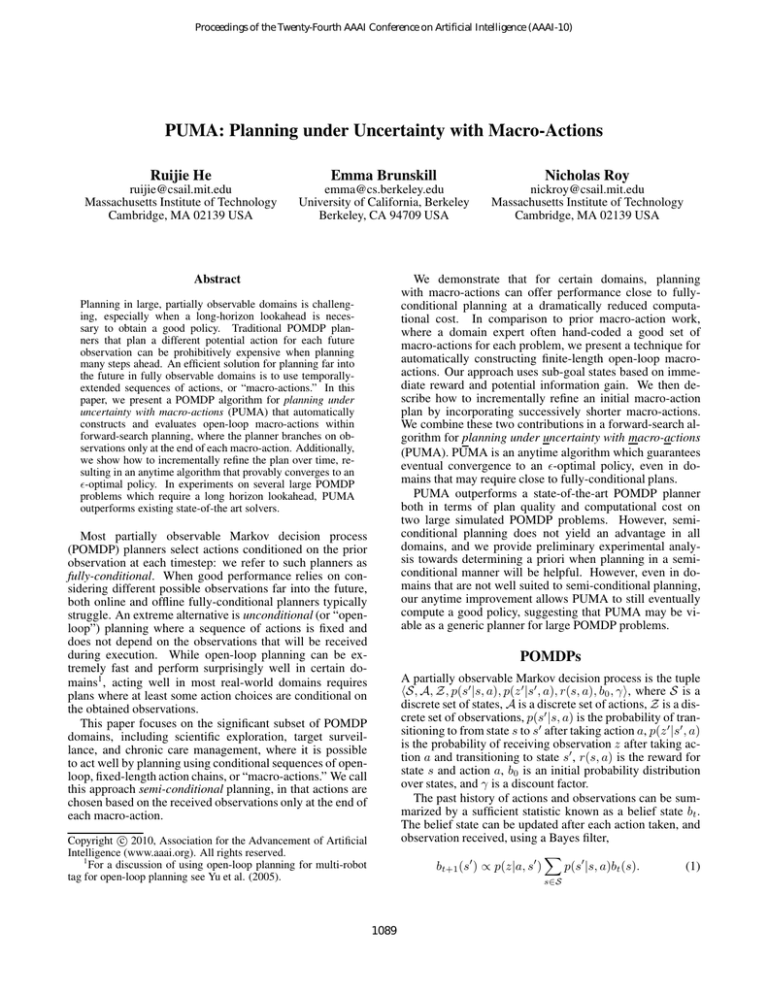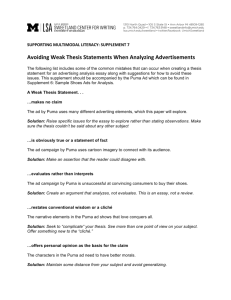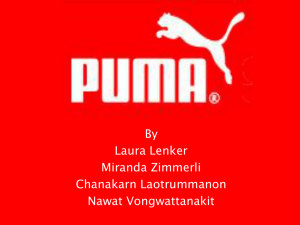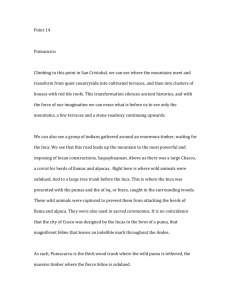
Proceedings of the Twenty-Fourth AAAI Conference on Artificial Intelligence (AAAI-10)
PUMA: Planning under Uncertainty with Macro-Actions
Ruijie He
Emma Brunskill
Nicholas Roy
ruijie@csail.mit.edu
Massachusetts Institute of Technology
Cambridge, MA 02139 USA
emma@cs.berkeley.edu
University of California, Berkeley
Berkeley, CA 94709 USA
nickroy@csail.mit.edu
Massachusetts Institute of Technology
Cambridge, MA 02139 USA
Abstract
We demonstrate that for certain domains, planning
with macro-actions can offer performance close to fullyconditional planning at a dramatically reduced computational cost. In comparison to prior macro-action work,
where a domain expert often hand-coded a good set of
macro-actions for each problem, we present a technique for
automatically constructing finite-length open-loop macroactions. Our approach uses sub-goal states based on immediate reward and potential information gain. We then describe how to incrementally refine an initial macro-action
plan by incorporating successively shorter macro-actions.
We combine these two contributions in a forward-search algorithm for planning under uncertainty with macro-actions
(PUMA). PUMA is an anytime algorithm which guarantees
eventual convergence to an ǫ-optimal policy, even in domains that may require close to fully-conditional plans.
PUMA outperforms a state-of-the-art POMDP planner
both in terms of plan quality and computational cost on
two large simulated POMDP problems. However, semiconditional planning does not yield an advantage in all
domains, and we provide preliminary experimental analysis towards determining a priori when planning in a semiconditional manner will be helpful. However, even in domains that are not well suited to semi-conditional planning,
our anytime improvement allows PUMA to still eventually
compute a good policy, suggesting that PUMA may be viable as a generic planner for large POMDP problems.
Planning in large, partially observable domains is challenging, especially when a long-horizon lookahead is necessary to obtain a good policy. Traditional POMDP planners that plan a different potential action for each future
observation can be prohibitively expensive when planning
many steps ahead. An efficient solution for planning far into
the future in fully observable domains is to use temporallyextended sequences of actions, or “macro-actions.” In this
paper, we present a POMDP algorithm for planning under
uncertainty with macro-actions (PUMA) that automatically
constructs and evaluates open-loop macro-actions within
forward-search planning, where the planner branches on observations only at the end of each macro-action. Additionally,
we show how to incrementally refine the plan over time, resulting in an anytime algorithm that provably converges to an
ǫ-optimal policy. In experiments on several large POMDP
problems which require a long horizon lookahead, PUMA
outperforms existing state-of-the art solvers.
Most partially observable Markov decision process
(POMDP) planners select actions conditioned on the prior
observation at each timestep: we refer to such planners as
fully-conditional. When good performance relies on considering different possible observations far into the future,
both online and offline fully-conditional planners typically
struggle. An extreme alternative is unconditional (or “openloop”) planning where a sequence of actions is fixed and
does not depend on the observations that will be received
during execution. While open-loop planning can be extremely fast and perform surprisingly well in certain domains1 , acting well in most real-world domains requires
plans where at least some action choices are conditional on
the obtained observations.
This paper focuses on the significant subset of POMDP
domains, including scientific exploration, target surveillance, and chronic care management, where it is possible
to act well by planning using conditional sequences of openloop, fixed-length action chains, or “macro-actions.” We call
this approach semi-conditional planning, in that actions are
chosen based on the received observations only at the end of
each macro-action.
POMDPs
A partially observable Markov decision process is the tuple
hS, A, Z, p(s′ |s, a), p(z ′ |s′ , a), r(s, a), b0 , γi, where S is a
discrete set of states, A is a discrete set of actions, Z is a discrete set of observations, p(s′ |s, a) is the probability of transitioning to from state s to s′ after taking action a, p(z ′ |s′ , a)
is the probability of receiving observation z after taking action a and transitioning to state s′ , r(s, a) is the reward for
state s and action a, b0 is an initial probability distribution
over states, and γ is a discount factor.
The past history of actions and observations can be summarized by a sufficient statistic known as a belief state bt .
The belief state can be updated after each action taken, and
observation received, using a Bayes filter,
X
bt+1 (s′ ) ∝ p(z|a, s′ )
p(s′ |s, a)bt (s).
(1)
c 2010, Association for the Advancement of Artificial
Copyright Intelligence (www.aaai.org). All rights reserved.
1
For a discussion of using open-loop planning for multi-robot
tag for open-loop planning see Yu et al. (2005).
s∈S
1089
The goal of POMDP planning is to compute a policy π : b →
a which map beliefs to actions, with the highest value function V π (b). V π (b) specifies the expected infinite-horizon
reward of executing policy π starting at any belief b,
X
X
V π(b)= r(s,π(b))b(s)+γ p(z|b, π(b))V π (bπ(b),z ). (2)
s∈S
of macro-actions at every step, and evaluates the values of
these macro-actions using forward search.
To generate macro-actions automatically, a naı̈ve approach would be to chain together randomly sampled primitive actions. However, the space of possible macro-actions
of maximum length L grows exponentially larger with L,
making it unlikely that a randomly-generated macro-action
would be the best possible open-loop action sequence that
the agent could have executed. In contrast, many macroaction planners in fully-observable domains create minipolicies designed to achieve sub-goals (for example, see McGovern 1998, and Stolle and Precup 2002). We hypothesize that sub-goals are similarly applicable within a POMDP
context.
z∈Z
Forward Search POMDP Planning
Current state-of-the-art, fully-conditional, offline planners,
such as the SARSOP algorithm (Kurniawati, Hsu, and Lee
2008), compute an explicit representation of the value function. In contrast, online forward search planners (see the survey by Ross, Pineau, Paquet and Chaib-draa, 2008) estimate
the belief-action value only for the current belief. The value
of each action is computed by constructing a forward search
tree that alternately expands potential actions, and branches
on possible observations, to a fixed horizon H.
Unfortunately, the computational complexity of fullyconditional forward search planning scales exponentially
with the horizon length, due to the breadth-first expansion
of possible actions and observations. Particularly for large
problems, the growth in cost with search depth typically limits a full forward search to a short horizon, causing poor
performance in problems that require a long lookahead. To
improve the performance of short horizon search, domainspecific heuristics can be used to approximate the value at
the leaves, but human intervention is required to choose the
heuristics. An alternative to heuristics is to compute an offline approximation of the value function to be used at the
tree leaves. Unfortunately it is often difficult to find a small
enough reduction of the original problem that can be solved
and yet still provides a good value estimate at the leaves of
the search tree.
By using macro-actions to restrict the policy space and reduce the action branching factor, semi-conditional forwardsearch POMDP planners can reduce the computational cost.
If à is the set of macro-actions and L is an upper-bound
on the length of each macro-action, the cost due to action
branching shrinks from O(|A|H ) to O(|Ã|H/L ). This reduction in computational complexity allows the planner to
search much farther into the future, which may enable good
plans to be found without relying on a heuristic at the leaves.
Implicit in this statement is the assumption that only a subset
of the potential macro-actions between lengths 1 to L will be
considered, otherwise the computational savings will be lost.
However, this choice also directly restricts the plan space
of the search process, possibly resulting in reduced performance. Therefore, it is crucial to be able to generate macroactions that are anticipated to be part of a good plan. Prior
work achieved this by hand-coding macro-actions (such as
work by He and Roy, 2009). In this paper we present an
automatic way to generate finite-length, open-loop macroactions that empirically produces good performance.
Reward exploitation/information gathering weights
To select suitable sub-goals, we take inspiration from Cassandra et al.’s 1996 and Hsiao et al.’s 2008 work showing
that good POMDP performance can be achieved by choosing either actions with high rewards or actions with a large
gain in information under the current belief. Our macroactions are therefore finite-length open-loop plans designed
to take the agent from a possible state under the current belief towards a state that will provide either a large immediate
reward or a large gain in information.
We compute two set of weights, wr and wi , that correspond to the reward exploitation and information gain metric, respectively. Two weights, wr (s) and wi (s) are computed for each state: these weights specify the probability
that the planner will choose state s as a sub-goal for generating a reward-exploitation or information-gain macro-action.
To calculate the reward exploitation weights, we first compute a reward exploitation heuristic (RE) for each state s:
RE(s) = max(RS (s, a) − Rmin )/(Rmax − Rmin ). (3)
a∈A
RE(s) is the best immediate reward for state s, normalized
by the minimum and maximum instantaneous rewards. This
ensures that RE is strictly positive. The reward exploitation
weights are computed by normalizing the heuristic values:
X
wr (s) = RE(s)/
RE(s).
(4)
s
To compute wi , we first compute an information gain
heuristic (IG) which computes the entropy associated with
the observation emission probabilities from each state s, versus a uniform distribution:
|Z| X
1
1
log(
) + p(zk |s) log(p(zk |s)) .
IG(s) =
−
|Z|
|Z|
k=1
The lower the entropy over the observation emission probabilities, the higher the probability that the agent will obtain
an observation that provides positive information about the
state of the world. To compute the information gain weights
we normalize the IG values to sum to one:
X
wi (s) = IG(s)/
IG(s).
(5)
Generating Macro-actions
The best macro-action that can be executed from any two
beliefs often varies greatly, especially since the two beliefs
could have support over very different regions of the state
space. Rather than using a large, fixed set of macro-actions
for every belief, our planner instead re-generates a new set
s
As both wr and wi are belief-independent, the sets of
weights only need to be computed once for each problem.
1090
Algorithm 1 G ENERATE M ACROS ()
Require: Current belief bc , Num macros M , Max length L
1: for k = 1 to M do
2:
Sample state ss,k from bc
3:
Vg ← 0
4:
while Vg (ss,k ) == 0 do
5:
Sample sub-goal state sg,k
6:
Compute “goal-oriented” MDP g for sub-goal sg,k
7:
end while
8:
j ← 1, Set state sc ← ss,k
9:
while j < L and state sc 6= goal state sg do
10:
ãk (j) = πg (sc ) (select action using MDP g policy)
11:
sc = argmaxs′ P (s′ |sc , ãk (j))
12:
j ←j+1
13:
end while
14:
Add macro-action ãk to Ã
15: end for
16: Return macro-action set Ã
Figure 1: Macro Action forward search tree
then receives an observation, updates the current belief using
Equation 1, and the cycle repeats.
To select an action for the current belief, we first generate
a set of M macro-actions with maximum length L from the
current belief bc using G EN M ACROS described in the previous section (Algorithm 1). We set M to always be at least
as large as the number of primitive actions |A|.
The forward-search tree is then constructed by considering the potential future action and observation trajectories from the initial belief state bc . The best macro-action
ãopt is the macro-action that has the highest expected future reward. To evaluate the expected reward of a macroaction, note that a macro-action ã of length L will generate a sequence of L beliefs [b0 , . . . , bL ] when executed.
Each belief P
will have an expected immediate reward r̃k
where r̃k = s r(s, ak )bk (s). The sequence of beliefs for a
macro-action is a function of the observations received during the execution of ã. As a result, the value of a macroaction is the expected value taken over all possible belief
sequences, according to the probability of each belief sequence given by the corresponding observation sequence.
For each posterior belief bL that results from each different observation sequence, we recursively compute the value
of the best macro-action from that posterior belief.
Therefore, to compute the expected reward for a macroaction ã from the root, we simulate its execution and generate all possible observation sequences from the root belief,
resulting in a set of possible expected rewards and posterior
beliefs. Posterior beliefs are sequentially updated according to Equation 1. For each posterior belief, we generate a
new set of macro-actions and again expand out the forward
search, as shown in Figure 1. We repeat this process until the
tree depth reaches a pre-specified horizon H. The expected
values of the beliefs are then carried back up the tree, taking
the maximum expected value over the macro-actions at each
belief, and the sum over observation sequences.
In practice, the number of possible observation sequences
that could occur during a single macro-action scales exponentially with the macro-action length L, for a total of
O(|Z|L ) sequences. To reduce the computational cost of
expanding all possible observation trajectories, when con-
Goal-oriented MDP
We will shortly describe how we use the computed weights
to sample a state sg,k . Given a sampled sg,k , we create
a “goal-oriented” MDP where sg,k has a high reward, all
other states have zero rewards, and the transition model is
identical to the POMDP transition model. A discount factor 0 < γ < 1 biases the policy towards action sequences
that will arrive at the goal state in the smallest number of
timesteps. The resultant MDP policy therefore provides a
mapping from states to actions, which maximizes a value
function that balances between the probability of reaching
the goal state and reaching that state in the shortest time possible.
Finally, bringing all the pieces together, to generate a
macro-action from the current belief state bc , we first sample a start state ss,k from bc . We then randomly choose
whether to use the reward exploitation weights wr or information gain weights wi , and then sample a sub-goal state
sg,k using the probabilities specified by the chosen weights.
We next check that under the goal-oriented MDP for sg,k ,
that the sampled start state ss,k can reach the goal state sg,k :
this is simple to verify as if ss,k cannot reach the goal, it will
have a value of zero in the goal-oriented MDP. Assuming the
sample goal can be reached from ss,k , we generate a macroaction by simulating execution of the goal-oriented MDP,
assuming that the maximum likelihood state is reached at
every step. Actions are added until either the sub-goal sg,k
is reached or the macro-action is of maximum length L. We
repeat the macro-action generation process M times for a
particular belief to generate M unique macro-actions. Algorithm 1 summarizes our macro-action generation process.
Forward Search Using Macro-Actions
We now present an initial version of planning under uncertainty using macro-actions via online forward-search. Our
algorithm builds upon a generic online forward search for
POMDPs (Ross et al. 2008), alternating between a planning
and execution phase at every iteration. During the planning phase, the best macro-action ãopt is chosen and the
first action at of this action sequence is executed. The agent
1091
updated. Note that we always include the value of the old Llength ãref ine when computing the new best macro-action,
therefore ensuring that the new policy space after a refinement has occurred always includes the old policy space.
This cycle repeats until all computation time available for
planning tplan has expired; this process gradually increases
the amount of conditional branching in the tree.
The process of generating macro-actions, performing an
initial search and then iterative improvement is our complete
planning under uncertainty with macro-actions algorithm,
PUMA.
Algorithm 2 PUMA
Require: Current belief bc , Planning horizon H, Planning
time tplan , Num macros M , Num obs. traj. samples Nz
1: telapsed = 0; L = H; be = bc
2: while telapsed < tplan do
3:
à = G EN M ACROS(be , M, L)
4:
for each macro-action ãk ∈ Ã do
5:
for i = 1 : Nz do
6:
Sample observation traj z̃i from be and ãk
7:
bi =U PDATE B ELIEF(be , ãk , z̃i )
8:
Compute V (bi ) by recursive forward search
9:
end for
PNz
10:
Q(be , ãk ) = i=1
V (bi )/Nz
11:
end for
12:
Choose ãref ine and bref ine to refine
13:
L = Length(ãref ine )/2; be = bref ine
14: end while
15: Return ãopt = argmaxã Q(bc , ã)
Analysis
For completeness we include the following performance
bound:
Theorem 1. Let H be the primitive-action horizon length
used in the PUMA algorithm. Assume that at least |Z|
unique observation sequences are sampled per macroaction. Then, as the amount of computational time available
for selecting an action increases, the PUMA policy followed
will converge to an ǫ-optimal policy where
structing a forward search tree, we only sample a small
number Nz of observation sequences for each macro-action,
which significantly reduces the computational complexity.
When the search reaches a depth of H primitive actions
(H/L macro-actions), the value of the posterior belief nodes
is set to zero. As mentioned previously, a common practice
is to use value heuristics at leaf nodes, but by being able to
search deeper efficiently, our macro-action planners instead
enable us to achieve good performance on several longer
horizon problems without using value heuristics to estimate
the cost-to-go from the leaf belief nodes.
ǫ=
γ H+1 maxa,s r(s, a)
.
1−γ
(6)
Proof. First note the PUMA macro-action creation process
ensures that at a given macro-action branching point, there
are always at least |A| unique macro-actions. As the amount
of time available to select an action for the root belief increases, the PUMA splitting criteria ensures that eventually
all macro-actions in the forward search tree will be refined
to length one. Combined with the prior condition on the
number of unique macro-actions and the stated assumption
on the number of unique sampled observation sequences, the
forward search tree will become a fully-conditional H-depth
tree, with all actions are expanded at each depth, followed by
all observations. Therefore, the action-values at the root belief will be exactly the H-step value of taking those actions
from the root belief. Now, recall from Puterman (1994) that
the difference between the belief-action H-horizon optimal
value QH (b, a), and the belief-action infinite-horizon optimal value Q∗ (b, a) is bounded:
Anytime Iterative Refinement
One limitation of our procedure for generating macroactions is that plans based only on open-loop action sequences between sub-goals may not correspond to the optimal, or even a good policy. In particular, so far we have
assumed that the user can provide a reasonable estimate of
the maximum macro-action length L. However, it may not
be obvious how to set L for a given problem; in some cases
where fully-conditional planning is required for good performance, every primitive action should depend on the previous observation and L should be 1. To handle this issue,
we extend the planner to allow the algorithm to converge to
ǫ-optimal performance for any POMDP in an any-time manner. Algorithm 2 shows the full PUMA algorithm.
If additional computation time is available after the initial tree is built and evaluated, we iteratively refine macroaction branches in the forward-search tree. To select the
next macro-action and belief node to refine, we find the
macro-action that is nearest to the root belief node and is of
length L > 1. Ties are broken arbitrarily. Once a macroaction ãref ine and belief node bref ine is chosen, the sequence of actions in the macro-action is pruned from its
original length (Length(ãref ine )) to a maximum length of
Length(ãref ine )/2. A new belief node b′ is created by taking the pruned macro-action from bref ine , and V (b′ ) is computed using forward search. The new value is propagated up
the tree, and if the root belief node bc has a macro-action
with a higher expected value, the best macro-action ãopt is
Q∗ (b, a) − QH (b, a) ≤
γ H+1 maxa,s r(s, a)
1−γ
(7)
Therefore, since in the limit of computational time PUMA
converges to the optimal H-horizon policy for the current
belief, the value of the PUMA policy is guaranteed to be at
worst ǫ-close to the optimal infinite-horizon policy.
Note Theorem 1 provides a principled way to select the
planning horizon H based on the desired ǫ value. In addition, Theorem 1 shows that PUMA removes a limitation of
many macro-action planners that do not guarantee good performance on problems that require a fully-conditional policy.
Performance and Planning Time
If all observation trajectories are exhaustively enumerated
and weighted by their probability, then the computed root
1092
belief-action values are the exact belief-action values of following the macro-action tree policy. Since the new policy
space after a macro-action refinement always includes the
original policy space, plus new potential policies due to the
additional conditional branching, the new (exact) computed
values at the root node will be at least the same value as they
were before the split occurred, or a higher value. In this case,
the computed root-belief node value is guaranteed to monotonically increase as the tree is iteratively refined given more
planning time.
The computational complexity of PUMA is a function of
the number of nodes in the forward search tree, plus an additional cost for macro-action generation. MDPs with different sampled sub-goals can be solved once and the solutions
stored, amortizing the cost over multiple steps of planning.
As we iteratively refine each macro-action, the number of
nodes grows to a full forward search. Therefore the PUMA
cost converges to the cost of a full forward search, plus the
overhead of iterative macro-action refinement.
Due to the prohibitive computational cost of enumerating all observation sequences in large horizons, PUMA
only samples a small number of observation trajectories per
macro-action. This yielded good empirical performance.
Noisy Tiger
SARSOP
Naive fs
PUMA
ISRS (8,5)
SARSOP
Naive fs
Hand-coded
PUMA
Tracking (50)
Naive fs
Hand-coded
PUMA
Ave. reward
Offline
time
Online
time
-38.61 ± 0.53
-41.19 ± 1.70
-41.67 ± 1.66
0.50
0.000
0.000
0.000
0.018
5.18
12.10 ± 0.26
9.56 ± 1.08
19.71 ± 0.63
17.38 ± 1.41
10000
0.000
0.000
0.000
0.000
3.36
0.74
162.48
19.58 ± 0.42
27.48 ± 0.49
35.55 ± 1.28
0.000
0.000
0.000
0.023
1.010
28.52
Table 1: Summary of experimental results using the best explored
parameters for each algorithm.
to 3 successive branches (H/3 = 5).
As a second example, we introduce a larger, multi-target
extension of the single target-tracking problem introduced
by Hsu, Lee, and Rong (2008): see Figure 2(c). At every timestep, each of the two targets move probabilistically
zero, one or two steps forward on a track with 50 states. The
agent can move along the track one or two steps forward, one
or two steps backwards, or can stay at the same spot. The
agent receives a large positive reward if it is in the vicinity
of the targets whenever either of the targets land in the yellow square regions, and a negative reward if it is not close to
a region when a target enters a yellow region. A small cost
is incurred for every movement action. The agent obtains
a noisy observation of the target’s position when it is in the
vicinity of the target.
Although this problem is inherently factored, offline approaches are typically unable to take advantage of the factored properties of the problem domains. The problem has
50 environmental states, but the model results in 503 =
125, 000 non-factored states, a problem that is not representable, let alone solvable, by offline non-factored approaches. Note that the forward search approach allows us
to exploit the factored nature of the problem domain for increased efficiency when updating the beliefs and calculating
expected rewards. We compared PUMA to a traditional forward search, as well as a macro-action forward search algorithm where the macro-actions were specified using domain
knowledge. Figure 2(d) shows that when a large number
of macro-actions are automatically generated, the PUMA
algorithm actually outperforms a policy using hand-coded
macro-actions.
Experiments
The PUMA algorithm consists of two phases: an initial
search process using automatically generated macro-actions,
and then a subsequent phase of any-time iterative improvement. In order to analyze these two phases, we first evaluated PUMA with no iterative improvement, and then examined the effect of the refinement process.
Experiments: Macro-Action Generation We first compared the PUMA algorithm without iterative improvement
to SARSOP (Kurniawati, Hsu, and Lee 2008), a state-ofthe-art offline POMDP planner. We begin with a variant of
the scientific exploration RockSample (Smith and Simmons
2004) problem called the Information Search Rocksample
(ISRS) problem (He and Roy 2009), shown in Figure 2(a).
In ISRS(n,k) an agent explores and samples k rocks in a
n × n grid world. The positions of the agent (pink square)
and the rocks (circles) are fully observable, but the value of
each rock (good or bad) is unknown to the agent. At every timestep, the agent receives a binary observation of the
value of each rock. The accuracy of this observation depends
on the agent’s proximity to rock information beacons (yellow squares) that each correspond to a particular rock. Unlike the original Rocksample problem, good performance on
ISRS requires searching far into the future, in that an agent
must plan first to visit beacons to identify the value of rocks
before sampling rocks. Information is physically separated
from reward.
The number of sampled macro-actions M is an input parameter: as we increase M PUMA quickly achieves performance equivalent to a macro-action algorithm that uses the
hand-coded macros (Figure 2(b)) at a slightly larger computational cost. This suggests our macro-action generation
algorithm is a good heuristic for finding effective macroactions. H was limited to 15 for computational reasons. L
was set to 5, based on experimental evidence that forwardsearch action branching is normally computationally limited
Experimental results: Refinement We examined the performance of iterative refinement on ISRS and tracking. As
the amount of available online computation time increases,
the iterative refinement of the macro-action forward search
tree improves performance in the ISRS problem, as shown
in Figure 3(a). Using 15 macro-actions at each branch
point, the algorithm evolves from being an unconditional
planner (L = H), where performance is worse than both
a traditional forward search and SARSOP, into a semiconditional planner where conditioning at different points
in the planning horizon results in better performance than
1093
(a) ISRS (8,5)
(b) PUMA performance (ISRS)
(c) Target-tracking (50)
(d) PUMA performance (Tracking)
Figure 2: (a) ISRS problem: Agent (purple square) has to retrieve rocks of high value (white circles). It receives noisy observations of
each rock’s value; observation accuracy increases with proximity to information beacons (yellow square). (c) Tracking: Yellow squares are
regions of high value. When the agent (helicopter) is over a target (cars) as the target enters a yellow square, a large positive reward is
obtained. If a target enters a yellow square without the agent present, a large negative reward is gained. (b,d) Performance of PUMA (blue
line) without refinement improves when more macro-actions are used, outperforming SARSOP (green dotted line) and for target-tracking,
even outperforming a forward search algorithm which uses hand-coded macro-actions (black cross).
(a) ISRS (8,5), PUMA 15 macro-actions
(b) Target-tracking (50), PUMA 5 macro-actions
(c) Noisy Tiger, PUMA 3 macro-actions
Figure 3: Performance of PUMA (blue line) as more planning time is allocated for iterative refinement, compared to traditional forward
search (red line) out to a progressively longer horizon, SARSOP (green dotted line), and hand-coded macro-action forward search (black
cross).
alternative POMDP approaches. Iterative refinement also
improves performance in the target-tracking problem (Figure 3(b)), though empirically the performance does not improve monotonically with more planning time.
We also applied PUMA to a POMDP benchmark problem, Tiger, to demonstrate that the design of PUMA still allows good performance on problems that are not well suited
to macro-actions, albeit at higher computational cost. Tiger
is a small POMDP problem that offers two challenges to
semi-conditional planners. First, it requires fully conditional
planning to achieve good performance. Second, good action sequences depend on multiple “listen” actions that do
not actually change the state itself: approaches such as the
Milestone Guided Sampling (MiGS) algorithm of Kurniawati et al. (2009) that generate macro-actions based only
on sampling state sub-goals will fail. To require planning
to a longer horizon, the observation noise was increased
from the standard model of 0.15 noise to 0.35 noise, such
that the agent has a lower probability of obtaining an accurate observation when it executes the “listen” action: we
call this “Noisy Tiger.” PUMA iteratively refines the macroactions until it reaches a primitive forward search of horizon
5, where all primitive actions are considered at each depth:
Figure 3(c) shows the PUMA algorithm converging towards
the optimal policy as more computation time is made available for planning. Table 1 summarizes the results of the different algorithms for each POMDP problem.
conditional planning is likely to be beneficial. Towards this
goal, our preliminary investigations suggest that reward variance is likely to be an important domain characteristic which
helps determines whether frequent conditioning on observations is required. More precisely, if Rµ (ai ) and Rσ (ai )
are the reward mean and variance, respectively, for action
ai over all states, the average reward variance Rσ can be
found by averaging Rσ (ai ) across all actions. A small Rσ
means that taking a particular action from any of the states
will result in very similar rewards, except perhaps for a few
states where the agent will receive a drastically different reward for taking the same action. Therefore, if Rσ is small,
a planner can often accurately calculate the expected reward
associated with a macro-action without having to condition
after every action.
We explored this hypothesis by first modifying the ISRS
problem so that the agent’s position is partially observable
and its transition model is stochastic. We also introduce
“potholes” into the problem, whereby the agent incurs a negative reward when it enters any grid cell with a pothole.
Increasing the number of potholes also increases the average reward variance Rσ . Figure 4 shows the performance of
PUMA, versus SARSOP, as the reward variance increases.
As the reward variance increases, the semi-conditional planner experiences a much steeper decline in performance relative to SARSOP, as our hypothesis predicted. Nevertheless,
measuring the reward variance alone ignores the observation
model and process noise, both of which affect the planner’s
ability to accurately plan for many steps in an open-loop
fashion. We seek to explore other criteria in future research.
Experiments: When to use semi-conditional planners?
To deploy semi-conditional planners effectively, it is necessary to understand the conditions under which a planner can generate good policies without having to condition on the observations after every action. Ideally one
would have a classifier function or score that, given an input POMDP specification, could determine whether semi-
Related Work
Macro-action planning formalisms for fully-observable environments include semi-Markov Decision Processes and
1094
Acknowledgements
We wish to thank the anonymous reviewers for their feedback. We would also like to thank Finale Doshi-Velez, Alborz Geramifard, Josh Joseph, and Javier Velez for valuable
discussions and comments.
References
Cassandra, A.; Kaelbling, L.; and Kurien, J. 1996. Acting under uncertainty: Discrete Bayesian models for mobile
robot navigation. In IROS.
He, R., and Roy, N. 2009. Efficient POMDP Forward Search
by Predicting the Posterior Belief Distribution. Technical
report, MIT.
Hsiao, K.; Lozano-Pérez, T.; and Kaelbling, L. 2008. Robust belief-based execution of manipulation programs. In
WAFR.
Hsu, D.; Lee, W.; and Rong, N. 2008. A point-based
POMDP planner for target tracking. In ICRA.
Iba, G. 1989. A heuristic approach to the discovery of
macro-operators. Machine Learning 3(4):285–317.
Kurniawati, H.; Du, Y.; Hsu, D.; and Lee, W. 2009. Motion
Planning under Uncertainty for Robotic Tasks with Long
Time Horizons. In ISRR.
Kurniawati, H.; Hsu, D.; and Lee, W. 2008. SARSOP:
Efficient Point-Based POMDP Planning by Approximating
Optimally Reachable Belief Spaces. In RSS.
McGovern, A., and Barto, A. 2001. Automatic discovery of
subgoals in reinforcement learning using diverse density. In
ICML.
McGovern, A. 1998. acQuire-macros: An algorithm for
automatically learning macro-actions. In NIPS AHRL.
Pineau, J.; Gordon, G.; and Thrun, S. 2003. Policycontingent abstraction for robust robot control. In UAI.
Puterman, M. 1994. Markov decision processes: discrete
stochastic dynamic programming. John Wiley & Sons, Inc.
New York, NY, USA.
Ross, S.; Pineau, J.; Paquet, S.; and Chaib-draa, B. 2008.
Online planning algorithms for POMDPs. JAIR 32:663–704.
Smith, T., and Simmons, R. 2004. Heuristic search value
iteration for POMDPs. In UAI.
Stolle, M., and Precup, D. 2002. Learning options in reinforcement learning. Lecture Notes in Computer Science.
Sutton, R.; Precup, D.; and Singh, S. 1999. Between MDPs
and semi-MDPs: A framework for temporal abstraction in
reinforcement learning. Artificial intelligence 112(1):181–
211.
Theocharous, G., and Kaelbling, L. 2003. Approximate
planning in POMDPs with macro-actions. NIPS.
Toussaint, M.; Charlin, L.; and Poupart, P. 2008. Hierarchical POMDP controller optimization by likelihood maximization. In UAI.
Yu, C.; Chuang, J.; Computing, S.; Math, C.; Gerkey, B.;
Gordon, G.; and Ng, A. 2005. Open-loop plans in multirobot POMDPs. Technical report, Stanford CS Dept.
Figure 4: Performance of PUMA (red line) relative to SARSOP (green dotted line) vs. reward variance.
the options framework (Sutton, Precup, and Singh 1999).
Prior work on macro-action generation includes the peakto-peak heuristic of Iba (1989) and the sub-goal method of
McGovern and Barto (2001).
For planning in partially observable MDPs, Pineau, Gordon and Thrun (2003) used a hierarchical approach for a
robotic task. Other POMDP macro-action robotics planners
by Theocharous and Kaelbling (2003), and Hsiao, LozanoPérez and Kaelbling (2008) provide good empirical performance, but do not focus on learning the macro-actions or
on providing performance guarantees. Recently Toussaint,
Charlin and Poupart (2008) presented an exciting inference
approach for automatically learning a hierarchical finite state
controller POMDP planner using expectation maximization,
though their experimental results struggled with some large
POMDP benchmark problems.
The closest related approach to PUMA is the MiGS algorithm by Kurniawati et al. (2009). There are three key differences between our PUMA approach and MiGS. First, iterative refinement enables PUMA to produce good solutions
for generic POMDPs, including domains like Tiger which
require sensing-only action sequences. The current implementation of MiGS will struggle because it only constructs
macros by sampling states, though it should also be possible
for MiGS to be extended to include an iterative refinement
component. Second, PUMA’s forward search procedure will
scale better in large spaces since MiGS is an offline approach
that uses a value function backup operator that scales as
O(|S|2 |Z||A|). Finally, PUMA can exploit factored models
to quickly compute belief updates and expected reward calculations for large state problems, but MiGS’ value function
representation cannot directly leverage factored structure.
Conclusion
In summary, we have presented an anytime semi-conditional
forward-search planner for partially observable domains.
PUMA automatically constructs macro-actions, and iteratively refines the macro-actions as planning time allows.
PUMA achieves promising experimental results relative to
state-of-the-art offline planners and a similar planner that
uses hand-selected macro-actions, on several large domains
requiring far-lookahead, and can also achieve good performance on domains that require fully-conditional planning.
1095






